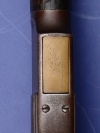
|
Winchester 1873 Saddle Ring Carbine |
This is a standard 3rd Model Winchester 1873 saddle ring carbine with 20" barrel, full magazine, carbine sights, semi-crescent carbine buttstock, and saddle ring. A nice correct example. The caliber is in .38 WCF, a.k.a. 38-40. We don't come across too many '73 carbines in 38-40 so this was kind of a neat find. We called the BBHC in Cody, WY to verify the factory records. It letters perfectly: Winchester Model 1873 Serial Number 386934 As we've noted in past write-ups on Model 1873's, the carbine version, in contrast to the sporting rifle configuration, was basically a utility gun. It was made for someone on the move who needed a gun with them, but one that was less of a chore to lug around. The carbine was short, lighter, and would easily fit in a leather scabbard for transport via horseback. In return, it offered a stunning amount of firepower for a single individual...at least by 19th century standards. The 1873 still had the clunky toggle link action that dated back to the S&W Volcanic of the 1850's, but it was a simple and reliable system that made the name "Winchester" a household word. The carbine version was the working man's gun and most show many years of use, scabbard wear, and little finish from having lived much of their working lives in the outdoors. It was the ideal choice of the 19th century American cowboy, lawman, shopkeeper, or just about anyone who might have needed to keep a gun handy...especially on horseback. The other part of the equation that made this gun very practical, especially in other parts of the world, was that it had central fire priming and could be reloaded with nothing more than an inexpensive pair of hand tools. Overall Condition grades to NRA Antique Good. This gun spent time on horseback as it shows some scabbard wear on the wood. The metal has turned to a gray patina that is turning to brown. Original rear sight has the "1873" designation at the top of the ladder and correct 200 to 900 yard graduations...not one of those later replacements with the 0...10...20 graduations on the ladders from circa 1910-30. Original solid post front sight. Original barrel has a nice two-line Winchester barrel address and caliber markings...at the 12 o'clock position or top of the barrel and no Winchester proofs...correct for an 1891 vintage Model 1873. Hammer has the decorative Victorian-era border design around the checkering...which Winchester used up to about 1900 on the Model 1873. Upper tang has the Model 1873 designation. The screws are in very good condition...not a single bad screw on this little carbine. It even still has its original saddle ring and ring pattern worn on the left side of the receiver. Good clear serial number. The brass cartridge lifter block has a nice uncleaned patina...but the "38 CAL" marking has almost worn completely away. If you look very closely however, you can still see shadows of the "38"...but nothing of the "CAL". This is fairly typical for carbines as the softer brass would wear and chafe in the scabbard or while being carried across the pommel of a saddle. Mechanics are good. Bore is Very Good with no rings or bulges. The walnut stocks show their share of scabbard wear and bruises, but are remarkably solid for a carbine. Many carbines have broken or replaced stocks. This one has no cracks or repairs, anywhere. The top right side of the forend has a good bit of scabbard wear...and a fairly smart bruise ahead of the rear band. As you will note in the pics, there is a line on the right side of the stock. This could have been a cowboy's simple mark for identifying his Winchester while it was in the scabbard or a notch for lashing an extra piece of rawhide to secure the gun on a horse. I've also seen similar marks on carbines where ranch hands used their carbines while stringing fences to pull a piece of barbed wire straight as it came off the spool. All in all, this is a very respectable example of an 1873 saddle ring carbine that definitely served its purpose...as a utility gun that was carried many a mile on horseback. Item# 1658 SOLD |
 |
 |
 |
|
 |
 |
 |
|
 |
 |
 |
 |
 |
 |
 |
|
 |
 |
 |
|
 |
 |
 |